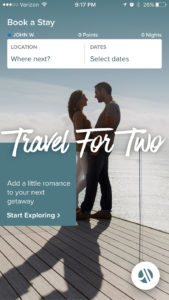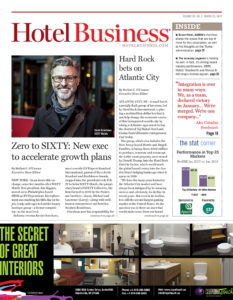BETHESDA, MD—Travel can be a hassle. Rushing through the airport, balancing a laptop bag with a coffee, and rolling a suitcase, all while trying to navigate through an app on your phone requires a certain amount of dexterity. But, certainly, these days that travel app is an essential part of the process, and as the guest journey has changed, Marriott International Inc. has developed an enhanced app to respond to that.
George Corbin, Marriott International’s SVP/digital, noted that the enhanced app is driven by customer data—app store reviews, in-app surveys (Marriott does about 5,000 a month) and a needs-based analysis: The company asks thousands of travelers what they’re trying to get done. “We don’t ask what features you want because everybody wants every feature, but then they don’t use them. We ask, ‘What are you trying to get done?’ We take that data, and that’s how we prioritize what we’re going to tackle next,” he explained.
First, Marriott tackled booking and linking to the loyalty program, as 80% said those were most important. “On the tail of that was more of these services related to what happens on property,” he said, noting that the enhanced app offers mobile check-in/checkout and room ready alerts (members can now request room upgrades and receive notification it has been fulfilled before they arrive, and can also request late checkout via the app); mobile requests, in which guests can chat directly with staff before, during or after the stay, or choose from a drop-down menu of the most frequent requests; and an expansion of mobile key (it’s rolling out to more than 500 hotels globally this year).
“We’re basically going down the list of what the customers have told us is most important, and we’re chipping away at that,” said Corbin.
Those in planning mode can also narrow down their destination searches by address or point-of-interest and can save their favorite hotels for quicker future bookings. The app will also deliver curated, original content from Marriott’s digital magazine, Traveler, based on the user’s previous searches or upcoming travel.
Personalization, said Corbin, was central to the redesign. “The redesign reflects that people are in different modes. Our home screen had been one-size-fits-all and now, it adapts according to where in the travel journey you are,” said Corbin. “If you have no upcoming stays, the home screen features booking. If you have an upcoming stay, the default will bring that screen up first. That will pull up things like the particulars of the hotel, directions, the button for mobile check-in, the button to make a service request. It is much more context based and cycles through according to where you are in the trip and what we think you are most going to need.”
Another design detail aims to help the on-the-go traveler. “We have this one-button approach. On the right-hand side, you can tap that button to cycle through the four screens,” he explained. “This is from the ethnographic observation that we see people rushing through airports pulling a wheelie bag with one hand, and they’ve got the phone balanced in the other. They can’t do it two-handed, so what can we do that’s just a thumb tap away? This design reflects that.”
 The redesign also reflects the company’s recent acquisition of Starwood Hotels & Resorts Worldwide Inc. If you’re looking at the visual identity and see some inspiration from the SPG app, that’s intentional. “It’s a design inspired by—and borrows heavily from—some of the design and visual identity that SPGers have seen recently,” Corbin explained.
The redesign also reflects the company’s recent acquisition of Starwood Hotels & Resorts Worldwide Inc. If you’re looking at the visual identity and see some inspiration from the SPG app, that’s intentional. “It’s a design inspired by—and borrows heavily from—some of the design and visual identity that SPGers have seen recently,” Corbin explained.
The changes reflect an increase in importance that the app has in overall strategy. “Travel is being disrupted. It has been for years, but now we’re seeing that accelerating,” Corbin said. “The customer is changing. We have gen X and gen Y accounting for three-quarters of room nights as early as next year. They also have a stronger propensity for the use of technology and for digital channels when conducting business with any travel brand. For instance, 75% of all stayed and paid guests—those who stayed and checked out—used one of our digital channels for their most recent stay. That’s a huge shift in consumer behavior.
“Google says 74% of all phones now have a travel app on them. People are looking to handle travel using mobile,” Corbin continued, noting that these changes are also altering the physical product—the hotels themselves. “Marriott has 30 brands, and some are targeted quite clearly at this emerging demographic. The product for the consumer has to change. The service has to change. That’s where digital comes in.”
And this actually gives hotels a better opportunity to increase guest satisfaction. “Across the industry, 24% of customers have a question or issue during their stay,” Corbin said. “Other statistics have shown that first-contact resolution means everything. If I have an issue and you resolve it satisfactorily on first contact, my satisfaction is going to be higher than guests who had no problem. This is service recovery and where mobile comes in. When we push out service requests, which we’ve now done at 4,000 hotels, that has a material impact on guest stay satisfaction… Those who had the mobile arrival experience have a materially higher guest stay satisfaction than those who did not use the mobile arrival experience. This is how you start to build loyalty and repeat business to the brand.”
How many people are using these features? “It continues to grow by double digits. We saw a 44% increase last year with mobile check-in and the arrival experience. People are taking to it,” said Corbin. “Part of the strategy here is the app is becoming the new front desk. There’s a number of services you’ve got available in your pocket on call all the time, and you don’t have to wait in line or pick up the phone in your room. You can tap and get it handled. The more of those types of services that we fold into the app, the higher the utility value of the app becomes because it’s more relevant at more moments and, ultimately, that’s what you’re after. Loyalty is built by proving yourself at all the micro moments.”
Later this year, Marriott will launch its mPlaces real-time app messaging with travel and hotel information, recognition and offers for Marriott Rewards members throughout their stays. This is based on beacons and guest intelligence data. “About 480 Marriott-brand hotels have beacons. We piloted at a couple dozen hotels,” explained Corbin. “Basically, our overall approach is to provide relevant service at the right moment. When you’re on property, there’s ample opportunity to do that as well. We put in these beacons and we zone out the hotel—break it up to anywhere between eight and 15 subzones within the hotel. If you have opted in, we will send relevant messages at the relevant moment. The line we have to walk here: We do not want your phone to become a spam cannon. We want to be respectful of your privacy, which is why we want the opt in, and we’re testing and learning. We want to be a service, not a nuisance.”
So if guests like to be recognized as they walk in, mPlaces will send a welcome message when they walk in the lobby for the first time. If the guest is an avid gym user, the app can send a message with the gym hours and location. “We have just tipped from this being marketing to being service,” explained Corbin. “If you’re within a certain vicinity and it fits with intelligence we have on you, then you’re getting the right message relevant to you for that moment. There’s a lot of experimentation, but we’ll start to push things out as we perfect and refine.
“We’re in the early days, but personalization is where we—and a lot of the industry—know we need to go,” Corbin concluded. HB

